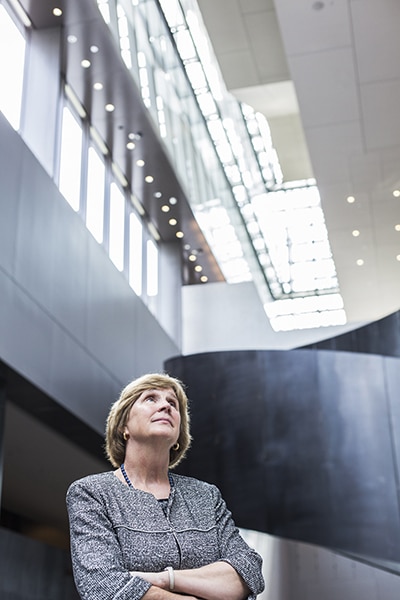Arguably the two most famous and precious airplanes in history are currently in boxes. The 1903 Wright Brothers Flyer, aviation’s first successfully controlled flying machine, and the Spirit of St. Louis, Charles Lindbergh’s pioneering New York-to-Paris transatlantic aircraft, are at present protected—in place but unseen—in their home: the Smithsonian National Air and Space Museum.
Why protected? Because the very popular Washington, DC, museum is undergoing renovations. First opened in 1976, it’s currently half-open as crews work, very carefully, around exhibits that cannot be moved. Other artifacts of air and space travel, meanwhile, have been safely moved to off-site storage.

The famous planes are just 2 of 154 million items in the 19 museums under the management of the Smithsonian Institution—in addition to the nine research centers and the National Zoo that the institution also oversees, part of a total of 641 Smithsonian buildings on 43,000 acres across the US and Panama. Started with the Castle, the flagship building erected near the National Mall in 1855, the collection of museums and research facilities exists to serve its original 1846 charter “for the increase and diffusion of knowledge.”

At the top of her thoughts are the 30 million annual visitors to the Smithsonian’s exhibitions and how to keep spaces open for them. “For about 80–90 percent of them, it’s a once-in-a-lifetime trip,” Bechtol says. “If we closed down the Air and Space Museum entirely for the renovation, we’d have a lot of disappointed visitors.” Hence the boxes and workarounds.

That museum is hardly the only structure being renovated or built new, though. The Smithsonian has also recently built the National Museum of African American History and Culture (opened in 2016) and renovated the Freer Gallery of Art (completed in 2017) and the National Museum of Natural History (upgraded to improve accessibility, with a five-year renovation of its Dinosaur and Fossil Hall to be finished in 2019). And, Bechtol’s single largest undertaking, a South Mall master plan, will set in motion a 20-year revitalization—projected to cost $2 billion—of that section of the campus. The Castle itself will be refurbished and revitalized as part of that project.
Heartening to know is that the new builds and renovations are also green. “We build to the highest LEED certifications possible,” Bechtol says. She is a signatory to a Sustainable Buildings Implementation Plan drawn up in 2010 that commits the institution to planning, designing, constructing, maintaining, and operating its owned and leased structures to standards that are “consistent with Federal environmental and energy-management requirements to the maximum extent practical.”
Using the LEED rating system as a guide, the Smithsonian is committed to such LEED categories as Sustainable Sites, which respects waterways and ecosystems of undeveloped sites. That might not seem meaningful in the long-established, densely built Capitol district, but the Smithsonian Marine Station at Fort Pierce, in Florida; the Smithsonian Tropical Research Institute, in Panama; and the Smithsonian Environmental Research Center, in Edgewater, Maryland (studying Chesapeake Bay), are all also part of the vast portfolio of facilities that Bechtol oversees.
The environmental concerns surrounding the museums and research facilities include their nonhuman occupants, too. The National Zoo, for example, like all Smithsonian properties, uses nontoxic cleaning products wherever possible. “Every chemical is reviewed by the head veterinarian to make sure we’re protecting the animals,” Bechtol says.
Such measures, along with the boxing of airplanes and the ensuring of wheelchair access, offer a hint at the interaction between facilities management and the people doing the work inside the Smithsonian’s structures. Collections managers and curators, with very specialized skills, are important stakeholders in what happens inside these buildings. So, too, are maintenance workers, who deal with the surprises and, well, bodily functions (human breath introduces a lot of humidity) of millions of visitors.
“Keeping floors clean is a constant,” Bechtol says. “Doors and hinges have to be almost industrial, able to handle constant opening and closing. Modern design favors clear glass, but we’ve learned over time, from university dorms and large airports, that a sturdy steel frame will last longer.”
And then, of course, there are the bathrooms, which Bechtol admits a certain obsession over. “When I’m on vacation, I take pictures of good bathrooms,” she says.
Bechtol says there is a rich talent pool in the DC area of people who know how to work with public and federal buildings that hold very important documents and artifacts. “It’s a competitive hiring environment right now,” she says, but she adds that “the Smithsonian is one of the most fabulous places to work.” She hires operations, design, safety, security, and maintenance staff from a mix of backgrounds: retired military personnel, people from the private sector, and experts from other museum and cultural institutions. “We want a team of all types,” Bechtol says. “I like them to blend their backgrounds, to listen to each other, and if they have a science background, they’re usually pretty good at figuring out why something broke.”
One museum that’s required their constant vigilance lately is the National Museum of African American History and Culture. Half of the 10-story structure, built in close proximity to the Washington Monument, is underground, but the water table is a mere five feet below the surface. “We had to pour a giant underground concrete bathtub around the museum and run a pump 24-7 to keep water out,” Bechtol says. And even with pump redundancy for backup, she says, “this is a difficult building.”

The challenges of Bechtol and her team’s work are not only physical but financial. Federal coffers provide about 60 percent of the capital and operating budgets for the Smithsonian—with no budget increases in sight—and the rest of the institution’s funding comes from private and corporate donations. The challenge is maintaining its reputation while doing more with less.
This includes maintaining optimal relationships with general contractors, architects, and other vendors, some of which work on years-long projects. “They are our partners on projects,” Bechtol says. “Every tradesperson who works with us can point to a building and say, ‘I contributed to building that museum.’” She bolsters that connection with team building retreats with contractors, where joint problem-solving is the goal.
The close work with vendors shows in their high praise for Bechtol. “Nancy challenges project teams to design spaces that navigate the realities of budget and time, protect the Smithsonian’s significant collections, and increase their access to the public,” says Jeffrey Hirsch, a principal and director of cultural practice for architecture firm Ewing Cole.
One can only envy Bechtol for the number of ribbon-cutting events she attends, where she gets to see dignitaries and tourists alike enter a space for the first time. “That’s what feeds the soul,” she says. But, every opening day begets what she calls “day-two projects,” where wayfinding and other kinks need to be worked out. “We see visitors every day in the museums,” she says. “It’s fun to be helpful. We’re all public servants, after all.”


